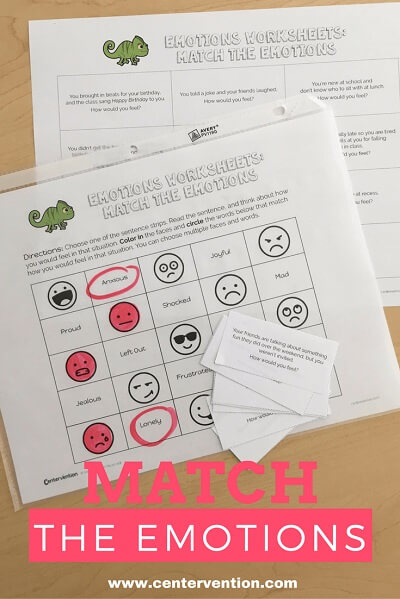We’ve created a fun, feelings faces lesson that invites students to explore their own reactions and feelings to different scenarios, compare their responses to their friends, and talk about why people might feel differently about a similar situation. Read on to learn how to incorporate this Match the Emotion into a variety of classroom activities!
Imagine a car without breaks, a running faucet without a tap, or a buzzing alarm clock with no off switch. The unsettling nature of all of these things depicts what happens when limits and control are not recognized. Without regulation, things quickly get out of hand and can become overwhelming. This idea is also true with emotions, and learning to recognize and manage them is an important skill which can be practiced in the classroom.
When processing a response to a situation– whether joyful, upsetting, or otherwise– people generally experience a similar range of emotions and are physiologically hardwired with a series of corresponding facial expressions. But since our interpretations and perspectives can vary based on life experiences, two people may have very different emotional reactions to the same situation. Understanding our own feelings and being able to appreciate those of others is a hallmark of empathetic thinking.

Recommended Grade Level: Elementary
SEL Skill(s): Emotion Regulation
Duration: 30 minutes
Materials:
- Feelings Poster
- Match The Emotions Worksheets
- Page Protectors
- Dry Erase Markers
- Mirrors (optional)
Feelings Faces Lesson Instructions
Gather students and show them the Feelings Poster. Tell them that you are going to play detective. Say:
“I have this poster of faces and they’re each showing a feeling, but we don’t know what the mystery feeling is. Help me solve the problem of what each of these faces might be.
Work through the faces on the poster and have students practice making each of the faces, passing around a mirror if possible. Ask students what feeling it looks like their friends are making and write their responses on the lines. Accept multiple answers since there are many words for similar feelings. After you give each of the faces some names, ask students to share times when they felt their own faces make those expressions. Say
“When are some times you have felt this way?”
Options for Feelings Faces Worksheets There are many great ways to extend the practice of exploring feelings through faces:
Bingo: Place one Match the Emotions (Emoji page) in a page protector for each student (or for pairs of students to share). Read out the scenario slips and have students identify which face and word describes how they would feel in that situation. Allow them to share their answers with peers to compare similarities and differences. Play a few rounds to see how many emotions can be marked off.
Question of the Day: Place a copy of the Match the Emotions (Emoji page) in each student’s binder or folder. Choose one of the scenario questions each day to read to the class and have students find which face represents their own reaction, and compare answers to that of a neighbor. (This can also be done on the rug as a large group with the Emoji page projected on the board).
Calm Down Corner: Place a copy of the Match the Emotions (Emoji page) in a page protector and hang it on the wall next to a mirror. Allow students to practice making the faces in the mirror as they choose scenario cards and act out their responses. This builds an awareness of how facial expression connects to internal feelings.